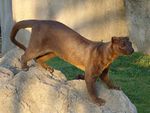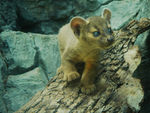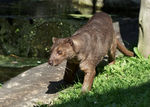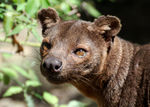Fossa
| Fossa |
|---|
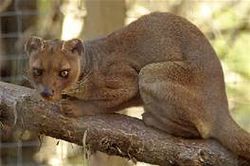
|
| Scientific Classification |
|
| Binomial Name |
|
Cryptoprocta ferox |
The Fossa Is the top predator on the island of Madagascar, hunting both day and night. Sadly its species has become critically endangered and can only be found on the island of Madagascar off the shore of Africa. They are the largest predatory mammal on the island. These carnivores are a close relative of the Mongoose family. They live deep in the forests of Madagascar using their sharp claws and long tails to go from branch to branch to find prey. like many other predators, their fur blends in with their surroundings, making them great hunters. The Fossa are solitary animals. They hunt anything that moves, their diet can consist of many different animal like reptiles, birds or even small monkeys. Scientists lucky enough to catch these animals in action praise their agility and ability to move so swiftly through the trees.[2]
Body Design
At first glance the fossa may seem like a part of the cat family, with its lean, slender body, and its incredibly long tail. It is capable of growing up to 6 feet long, from nose to tail tip and weighing up to 26 pounds. [3]Though it shows little resemblance, the fossa is actually more closely related to the mongoose family. This can be seen more clearly in its face features. They have small heads, with large rounded ears, big eyes, and a short muzzle. They also have short, but extremely sharp, semi- retractable, claws. The males are usually much larger than females. And they tend to have a short coat, which is usually a reddish-brownish color.[4]
Life Cycle
The fossa is a solitary species, with the exception of mothers with their young and their brief pairings during mating season. It spends its time both in the trees and on the ground. It is also both active at night and during the day. Females usually give birth to an annual litter of two to four young, approximately three months after breeding. When born they are blind and helpless, each pup weighing only around 100g. The young start becoming somewhat independent, not completely relying on their mother for milk, at about four to five months. Despite their growing independence, they still remain with their mothers until they are fifteen to twenty months old. They don't seem to reach sexual maturity until they're four years old. The Fossa's lifespan in the wild is unknown, although, in captivity, they have been known to live up to more than twenty years.[5].
They are very agile making them excellent leapers and climbers. The fossa’s long, slender tail is a huge asset that helps provide balance as it moves quickly and swiftly through the trees. They are able to move so fast that it can be very hard for researchers to get the data they are after with this animal. Due to its retractable claws and its muscular build it is able to climb up and down trees head-first. It walks on the soles of its feet, similar to the ways of a bear. This gives them extra balance and a lot more stability when they leap from branch to branch. A great deal of their time is spent in the trees, but they are on the ground frequently as well. The fossa are a resourceful species that adapts well to its habitat, so they do what works well for them during any given time in environment. [6]
The fossa's mating system, which occurs in September and October, is a rather unusual one. It Begins with A receptive female occupying a site high in a tree. She will then meow to attract males. Below many males will meet and compete for her affection by yowling. Throughout the course of a week or so the female will mate with many of the males who show up. After this female has left another will take her place and also mate with the males there. Each period of copulation may go on for several hours. This lengthy mating is partly due to the backwards-pointing spines on the male’s penis, which results in a copulatory tie that is difficult to break. The fossa will reuse these same mating trees for years. These same trees will be frequently used year after year. This mating system, in which a female acquires a site and chooses her mates, is unique among carnivores. [7].
Ecology
The fossa can be found in Madagascar, where as an endangered species, it is struggling to maintain its population. It has been spotted in several different regions in and around Madagascar. [7]The fossa can live in forests, coastal lowlands, and mountain areas up to 6,560 feet. Including in western deciduous dry forests, eastern rainforests, and the southern spiny forest. However they are most frequently seen living in humid and tropical climates rather than dry.[5]
Masculinization trait
The fossa, being an incredibly unique mammal, has many unusual traits. Maybe, the most unusual being its genitalia? More specifically the masculinization of the female fossa's genitalia. This is seen only in the young between eight and eighteen months appearing to diminish with age. During their juvenile stage the females clitoris enlarges and covers in spines, mimicking the appearance of the penis in the male. [8] The cream fur surrounding the females underparts becomes covered by a orange colored secretion, again, normally seen only in adult males. There is no evidence found to link this masculinization to elevated female androgen levels. There have been many proposed explanations to this temporary female masculinization, but it is still unclear if this has any adaptive purposes. [9].
Video
References
- ↑ Fossa Wikispecies. Last modified on 2 January 2016. Unknown author.
- ↑ Fossa Nature lets discover. Web. date accessed February 9, 2016. unknown author.
- ↑ The Creature WIRED. Web. date accessed February 9, 2016. unknown author.
- ↑ Fossa The Animal Files. Web. date accessed February 9, 2016. unknown author.
- ↑ 5.0 5.1 Fossa National Geographic. Web. date accessed February 9, 2016. unknown author.
- ↑ The Creature WIRED. Web. date accessed February 9, 2016. unknown author.
- ↑ 7.0 7.1 Fossa. Edge evolutionarily distinct and globally endangered. Web. date accessed February 9,2016. unknown author.
- ↑ Fossa World association of zoos and aquariums WAZA. Web. date accessed February 9, 2016. unknown author.
- ↑ Clare E. Hawkins, John F. Dallas, Paul A. Fowler, Rosie Woodroffe, and Paul A. Racey. Transient Masculinization in the Fossa, Cryptoprocta ferox (Carnivora, Viverridae) BioOne. Web. Date Published October 10, 2001.
